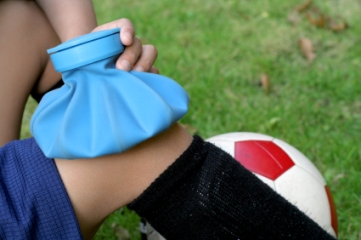Patellofemoral Dysfunction, also known as patellofemoral syndrome or instability, commonly affects young athletes in a variety of sports. Athletes will complain of symptoms including difficulty with stairs, occasional swelling, and sometimes "painful popping" when getting out of a chair. So what can be done to address this problem?

The quadriceps muscle, located in the front of the thigh, has the most impact on the positioning of the knee. The muscle group pulls from 4 different angles, each producing a different effect on the kneecap. A good analogy is 4 ropes centered about a ring pulling in various directions. If one rope is not pulling hard enough, the ring with shift to the strong side.
Athletes with a shallow trochlear groove (pathway for the knee cap), small patella size, and general joint laxity are very sensitivity to this muscle imbalance. The Vastus Medialis Oblique (VMO), an inner knee thigh muscle, when weakened will cause the patella to glide outward, increasing risk of pain or dislocation.
Groundbreaking research
Research conducted by Miho J. Tanaka, associate physician to the St. Louis Cardinals, has determined that lack of quad activation contributes to the lateral tilting of the kneecap. Combined with over-activation or tight hamstrings,, it increases the migration of the patella outward, resulting in debilitating pain and increasing pressure, while wearing away cartilage. As symptoms progress for months, even years without diagnosis, the knee gradually progresses to a chronic condition that is difficult to treat, sometimes requiring surgical intervention. Even with surgery, outcomes for a pain-free return to sports and daily activities are less likely than with other more common procedure, such as ACL reconstruction.
Early intervention is critical
The most important way to reduce the short- and long-term affects of poorly positioned kneecaps is early intervention. As previously mentioned, symptoms of achy knees often go untreated for months, even years causing irreversible damage to the cartilage. Any athlete experiencing chronic knee pain (for more than 2 weeks) should be seen by an orthopedic physician to determine the cause. Commonly, physical therapy is recommended to strengthen the quad, teach stretching exercises, and guide appropriate biomechanics. Allowing knee pain to persist only decreases the potential for return to pain free sport.
Dr. Cronin gratefully acknowledges the assistance of Miho J. Tanaka, MD, Director of Women's Sports Initiative at Regeneration Orthopedics, and Associate Team Physician for the St. Louis Cardinals, in the preparation of this article. This is the first in a series of articles by Dr. Cronin with physicians from the Cardinals.
Posted April 29, 2013








